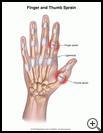
Finger Sprain
What is a finger sprain?
A finger sprain is an injury to a joint that causes a stretch or tear in a ligament. Ligaments are strong bands of tissue that connect one bone to another.
How does it occur?
A sprain usually occurs when there is an accident. For example, a ball may hit the tip of your child's finger or the child may fall forcefully onto the finger.
What are the symptoms?
Your child will have pain, swelling, and tenderness in the finger.
How is it diagnosed?
Your child's healthcare provider will examine the finger. An X-ray may be taken to be sure none of the bones are broken.
How is it treated?
Treatment may include:
- Putting ice packs to your child's finger for 20 to 30 minutes every 3 to 4 hours for 2 or 3 days or until the pain goes away.
- Elevating your child's hand on a pillow while they are lying down or on the back of a chair or couch while they are sitting (to help reduce swelling).
- Giving your child an anti-inflammatory or other pain medicine prescribed by your child's healthcare provider.
- Having your child do exercises to strengthen their finger during the healing process.
Your child's healthcare provider will probably recommend that the sprained finger be splinted or "buddy taped" (taped to the finger next to it) for 1 to 4 weeks after the injury.
How long will the effects last?
Your child's finger may remain swollen with decreased flexibility and strength for many weeks. Sometimes the joint swelling may take weeks or months to go away and in some cases may be permanent. It is important that your child continues doing finger exercises during and even after returning to normal activities. These exercises help strengthen your child's finger and improve range of motion.
When can my child return to normal activities?
Everyone recovers from an injury at a different rate. Your child's return to activities depends on how soon the finger recovers, not by how many days or weeks it has been since the injury happened. In general, the longer your child has symptoms before starting treatment, the longer it will take to get better. The goal is to return to normal activities as soon as is safely possible. If your child returns too soon the finger may get worse instead of better.
In many cases, your child will be able to return to sports or activities as long as he or she wears a splint or has the fingers taped together.
Last modified: 2010-01-08
Last reviewed: 2009-12-28

